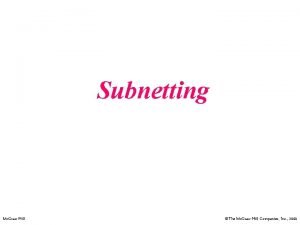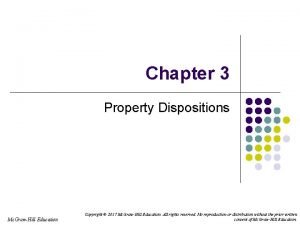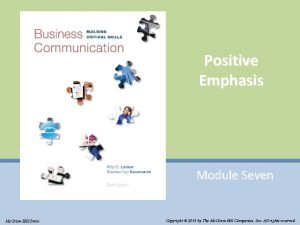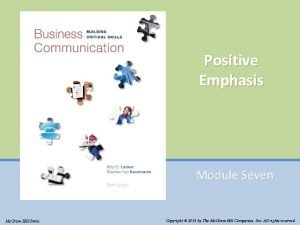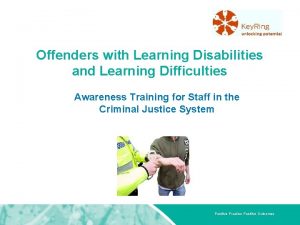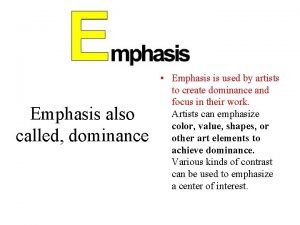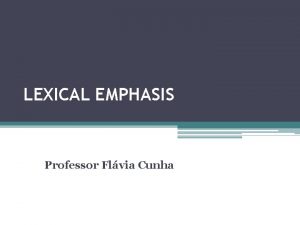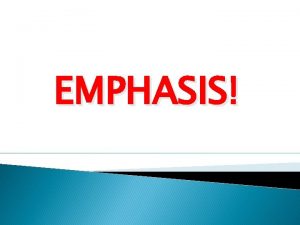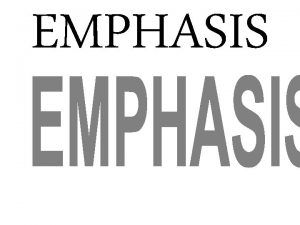Positive Emphasis Module Seven 2014 The Mc GrawHill






















- Slides: 22

Positive Emphasis Module Seven © 2014 The Mc. Graw-Hill Companies, Inc. All rights reserved Mc. Graw-Hill/Irwin Copyright © 2014 by The Mc. Graw-Hill Companies, Inc. All rights reserved.

Learning Objectives LO 7 -1 Apply strategies for positive emphasis use. LO 7 -2 Analyze situations for ethical positive emphasis. LO 7 -3 Explain reasons for tone, politeness, and power considerations. LO 7 -4 Identify situations for apologies. 7 -2

Some Negatives Are Necessary To build credibility when giving bad news. To help people to take a problem seriously. 7 -3

Some Negatives Are Necessary To deliver a rebuke with no alternative. To create a “reverse psychology” to make people look favorably at your product or service. 7 -4

How do I create positive emphasis? Avoid negative words. Focus on what the reader can do. Justify a negative—give a reason or link it to a reader benefit. Omit unimportant negatives. Put the negative in the middle and present it compactly. 7 -5

Negative Words to Avoid 7 -6

Avoid Negative Words and Words with Negative Connotations Replace negative words with positive words Negative: We have failed to finish taking inventory. Better: We haven’t finished taking inventory. Still better: We will be finished taking inventory Friday. 7 -7

Avoid Negative Words and Words with Negative Connotations Negative: If you can’t understand this explanation, feel free to call me. Better: If you have further questions, just call me. Still better: Omit the sentence. (Readers aren’t shrinking violets. They’ll call if they do have questions. ) 7 -8

Avoid Negative Words and Words with Negative Connotations Omit double negatives Negative: Do not forget to back up your disks. Better: Always back up your disks. 7 -9

Avoid Negative Words and Words with Negative Connotations Use the least negative term that is accurate Negative: Your balance of $835 is delinquent. Better: Your balance of $835 is past due. 7 -10

Avoid Negative Words and Words with Negative Connotations Removing negatives does not mean being arrogant or pushy. Negative: I hope that you are satisfied enough to place future orders. Arrogant: I look forward to receiving all of your future business. Better: Call Mercury whenever you need transistors. 7 -11

Avoid Negative Words and Words with Negative Connotations Use specifics to be both positive and accurate Negative: The exercycle is not guaranteed for life. Not true: The exercycle is guaranteed for life. True: The exercycle is guaranteed for 10 years. 7 -12

Focus on What the Reader Can Do Rather than on Limitations Negative: We will not allow you to charge more than $1, 500 on your VISA account. Better: You can charge $1, 500 on your new VISA card. or: Your new VISA card gives you $1, 500 in credit that you can use at thousands of stores nationwide 7 -13

Justify Negative Information by Giving a Reason or Linking It to a Reader Benefit Negative: We cannot sell computer disks in lots of less than 10. Loophole: To keep down packaging costs and to help you save on shipping and handling costs, we sell computer disks in lots of 10 or more. 7 -14

Justify Negative Information by Giving a Reason or Linking It to a Reader Benefit Better: To keep down packaging costs and to help customers save on shipping and handling costs, we sell computer disks only in lots of 10 or more. 7 -15

If the Negative Is Truly Unimportant, Omit It Omit negatives entirely only when: The reader does not need the information to make a decision. You have already given the reader the information and he or she has access to the previous communication. The information is trivial. 7 -16

If the Negative Is Truly Unimportant, Omit It Negative: A one-year subscription to PC Magazine is $49. 97. That rate is not as low as the rates charged for some magazines. Better: A one-year subscription to PC Magazine is $49. 97. Still better: A one-year subscription to PC Magazine is $49. 97. You save 43% off the newsstand price of $87. 78. 7 -17

Bury the Negative Information and Present It Compactly To deemphasize a negative, put it in the middle of a paragraph rather than in the first or last sentence, in the middle of the message rather than in the first or last paragraphs. 7 -18

Using Positive Emphasis Ethically Don’t omit necessary details. Focus on what the reader can do rather than on limitations only when the situation is appropriate. Presenting information in type large enough to be read easily. Don’t obscure meaning by using less common terms. 7 -19

Why do I need to think about tone, politeness, and power? Tone 9 the implied attitude of the writer toward the reader Don’t use the same tone with a superior as with a peer or subordinate. 7 -20

Why do I need to think about tone, politeness, and power? Use courtesy titles for people outside the organization you don’t know very well. Be aware of the power implications of words. When the stakes are low, be straightforward When you must give bad news, consider hedging your statement. 7 -21

What’s the best way to apologize? No explicit apology is necessary if the error is small and if you are correcting the mistake. Do not apologize when you are not at fault. When you apologize, do it early, briefly, and sincerely 7 -22
 Semantic translation contoh
Semantic translation contoh Grawhill
Grawhill Grawhill
Grawhill 作業管理精簡版13版解答
作業管理精簡版13版解答 Grawhill
Grawhill Mc graw hill
Mc graw hill Mc grawhill
Mc grawhill Grawhill
Grawhill Mc grawhill
Mc grawhill Grawhill
Grawhill Positive emphasis
Positive emphasis Positive emphasis
Positive emphasis The seven virtues series
The seven virtues series C device module module 1
C device module module 1 Catalase test
Catalase test Positive + positive equals
Positive + positive equals Positive practice positive outcomes
Positive practice positive outcomes Hát kết hợp bộ gõ cơ thể
Hát kết hợp bộ gõ cơ thể Lp html
Lp html Bổ thể
Bổ thể Tỉ lệ cơ thể trẻ em
Tỉ lệ cơ thể trẻ em Voi kéo gỗ như thế nào
Voi kéo gỗ như thế nào Tư thế worm breton
Tư thế worm breton




